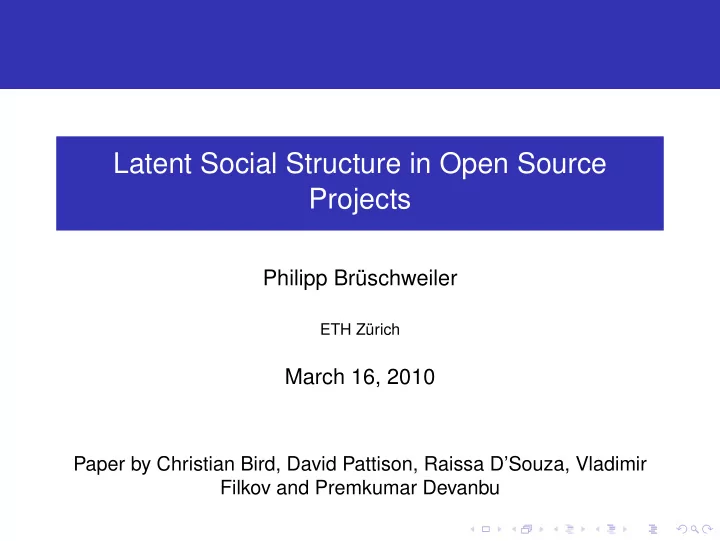

Latent Social Structure in Open Source Projects Philipp Brüschweiler ETH Zürich March 16, 2010 Paper by Christian Bird, David Pattison, Raissa D’Souza, Vladimir Filkov and Premkumar Devanbu
Research Question Number of interactions grows quadratically with team size Divide and conquer
Research Question Number of interactions grows quadratically with team size Divide and conquer Open Source Software (OSS) projects not formally organized
Research Question Number of interactions grows quadratically with team size Divide and conquer Open Source Software (OSS) projects not formally organized Latent social structure? Not explicit, but observable
Studied Projects Ant Apache Python Perl PostgreSQL
Project Selection Criteria Well-known and stable projects
Project Selection Criteria Well-known and stable projects Complex codebases with several subsystems
Project Selection Criteria Well-known and stable projects Complex codebases with several subsystems Different governance structures Foundation (Apache and Ant)
Project Selection Criteria Well-known and stable projects Complex codebases with several subsystems Different governance structures Foundation (Apache and Ant) Community (PostgreSQL)
Project Selection Criteria Well-known and stable projects Complex codebases with several subsystems Different governance structures Foundation (Apache and Ant) Community (PostgreSQL) Monarchist (Python and Perl)
Data Mining Build social network of mailing list participants
Data Mining Build social network of mailing list participants Download and parse mailing list archives Reconstruct threads of conversation Answers to emails ⇔ create link between authors
Data Mining Build social network of mailing list participants Download and parse mailing list archives Reconstruct threads of conversation Answers to emails ⇔ create link between authors Extract code information Author and time of commit File names, file contents
Data Mining Build social network of mailing list participants Download and parse mailing list archives Reconstruct threads of conversation Answers to emails ⇔ create link between authors Extract code information Author and time of commit File names, file contents Time intervals of 3 months
Finding Community Structure – Modularity Network partitioned into groups
Finding Community Structure – Modularity Network partitioned into groups � 2 � inside i all i Modularity: � − i n n inside i : number of connections inside group i all i : number of all connections to or from group i (including inside i ) n : total number of connections
Finding Community Structure – Modularity Network partitioned into groups � 2 � inside i all i Modularity: � − i n n inside i : number of connections inside group i all i : number of all connections to or from group i (including inside i ) n : total number of connections Intuition: ratio of connections inside groups vs. between groups
Finding Community Structure – Modularity Values between 0 and 1 0: not modular 1: disconnected complete graphs
Finding Community Structure – Modularity Values between 0 and 1 0: not modular 1: disconnected complete graphs Modularity of known modular networks ranges from 0.3 to 0.7
Finding Community Structure – Modularity Values between 0 and 1 0: not modular 1: disconnected complete graphs Modularity of known modular networks ranges from 0.3 to 0.7 Find partition of the network that yields highest modularity
Finding Community Structure – Modularity Values between 0 and 1 0: not modular 1: disconnected complete graphs Modularity of known modular networks ranges from 0.3 to 0.7 Find partition of the network that yields highest modularity NP-complete, approximation used
Example Network This network has modularity 0.39
Spontaneous Formation of Subcommunities Hypothesis 1 Mailing list participants spontaneously form subcommunities and the modularity values of these subcommunities will be significant.
Strong Community Structure Very significant when compared to random network Hypothesis 1 confirmed
Product and Process Messages Product messages About code
Product and Process Messages Product messages About code Process messages Everything else, e.g., high-level architecture discussions
Product and Process Messages Product messages About code Process messages Everything else, e.g., high-level architecture discussions Automatic classification by scanning for names of files, functions, classes, . . .
Higher Modularity of Product Messages Hypothesis 2 Modularity values of networks constructed from only product messages will be higher than when only process messages or all messages are used.
Hypothesis Confirmed Hypothesis 2 confirmed Successful projects focus into subcommunities for product-related work
Subcommunities Signify Collaboration Hypothesis 3 Pairs of developers within the same subcommunity will have more files in common than pairs of developers from different subcommunities.
Defining Collaboration Compare number of files worked on by developers in the same subcommunity different subcommunities
Hypothesis Confirmed Hypothesis 3 confirmed Social interaction linked with programming collaboration
Subcommunities are Focused Hypothesis 4 Subcommunities focus their attention to small parts of the system, so the average directory distance of files worked on by a subcommunity will be small.
Directory Distance Directory distance is the tree distance in the directory tree
Directory Distance Directory distance is the tree distance in the directory tree Find average directory distance of files that were worked on by a subcommunity
Directory Distance Directory distance is the tree distance in the directory tree Find average directory distance of files that were worked on by a subcommunity Compare to random samples of developers
Hypothesis Not Confirmed No significantly lower directory distance Hypothesis 4 not confirmed
Hypothesis Not Confirmed No significantly lower directory distance Hypothesis 4 not confirmed Possible explanations: Hypothesis incorrect
Hypothesis Not Confirmed No significantly lower directory distance Hypothesis 4 not confirmed Possible explanations: Hypothesis incorrect Directory distance no good measure for task focus
Conclusion OSS projects have strong social structures
Conclusion OSS projects have strong social structures Code discussion more modular than general discussion
Conclusion OSS projects have strong social structures Code discussion more modular than general discussion Social interaction is linked with programming collaboration
Recommend
More recommend